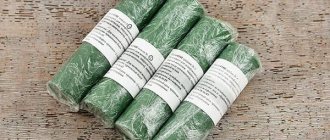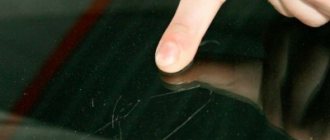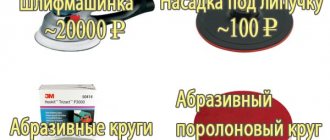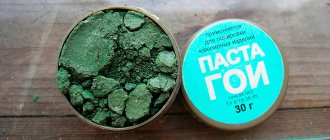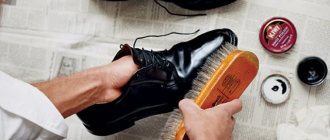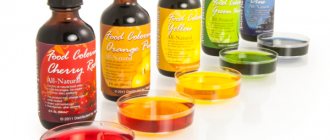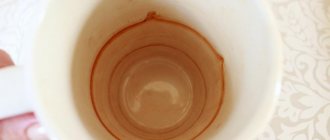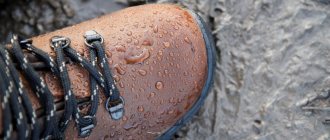Polishing agents are used for grinding and polishing metal, ceramic, plastic, stone or glass surfaces. In the CIS countries, the most widely used paste is GOI, developed by the USSR State Optical Institute in 1931-1933. The material is suitable for use at home and in production (in galvanizing shops).
History of pasta
This polishing agent was developed in our country a very long time ago - in the 30s of the twentieth century. It was invented by specialists from the State Optical Institute. Hence the name of the paste (based on the first letters) - GOI. For almost a hundred years, this product has been used to polish steel, other metals, ceramics, plastics, stone and even glass. Our grandfathers knew how to use GOI paste. Initially, it was made from chromium oxide and auxiliary substances and had a green color. Today, such a product can also be found in stores and on the market. However, the production of green pasta is currently prohibited and discontinued. The fact is that chromium oxide is a toxic carcinogen. Modern GOI pastes are white or red in color and are made from aluminum oxide. Using the second type, polishing is faster. Using white paste you can get a better and smoother surface.
Composition and varieties
Trivalent chromium oxide is used as an active component in GOI paste, which gives the material a green color. Additionally, binders and other additives are used: stearin, fat, oleic acid, kerosene, baking soda, silicate gel (silicon dioxide). The old formula used hexavalent chromium oxide, but it had to be abandoned because the substance causes cancer. It is not safe to use old paste of dubious origin.
The material is produced in the form of solid bars or a viscous mass supplied in jars. Available at any store that sells polishes. It is sometimes mistakenly called "goye" or "Goya paste". The use of trivalent chromium oxide makes up 60−85% of the substance. The color of the composition and the size of the granules (and, as a consequence, the abrasive characteristics) depend on the percentage of the active substance. A total of 4 types of polishing agents are produced:
- Rough (No. 4) . Used for grinding or rough polishing of surfaces. Easily removes the top layer of material, removes large scratches, irregularities, potholes, and risks. Contains 80−85% chromium oxide. Has a light green tint.
- Average (No. 3) . Used to give a matte finish to surfaces. Removes marks, minor irregularities, scratches. Up to 76% active substance, pure green tint.
- Thin (No. 2) . Used for polishing jewelry, metal, glass, and plastic products. Acceptable for finishing. The paste has a dark green tint and contains up to 74% chromium oxide.
- Thin (No. 1) . Used for finishing any surfaces. The only paste suitable for delicate materials. The dark mass with a green tint consists of 60-70% chromium oxide.
In production, thin pastes are used for grinding and final finishing of product surfaces. They are the ones who give shine and shine. At home, composition No. 2 is used for most work and materials.
Varieties of Green Pasta
We’ll talk about how to use GOI paste correctly below. Now let's see what varieties of this material exist. Once upon a time, three types of GOI green paste were produced. And today, in a store or online, you can purchase a product with different sizes of abrasive particles:
- No. 4 - intended for initial rough polishing of surfaces;
- No. 3 - gives the surface a matte appearance, while no strokes are visible on it;
- No. 2 and No. 1 - used for finishing and give a glossy surface.
The green variety was produced both in solid bars and in the form of a more liquid paste-like mass (in boxes). The popularity of both types is due not only to the high quality of polishing, but also to their more than affordable price.
How to care for silver
Silver is loved for its nobility at an affordable price. Products made from this metal can serve their owner for many years, but caring for silver jewelry requires care and patience. Silver is most often subject to deformation due to its softness; it becomes covered with scratches, can bend and turn black. To prevent silver from tarnishing, it should be cleaned regularly. You can do this on your own and with improvised means that are present in every person’s household, or you can take it to a master. The latter option costs money, but you will receive the jewelry back intact, like new.
What to do before polishing
So, let's start figuring out how to use GOI paste. The small particles contained in it, when rubbing the surface, remove a thin layer along with scratches and microcracks. Polishing is usually done using a soft cloth dipped in gasoline (you can use a lighter). Apply a small layer of paste onto it and rub it a little on an unnecessary piece of metal. This is necessary so that any too large pieces in the paste are broken. If they remain, the surface may not be polished, but rather scratched. The cloth should be really soft. You can take, for example, flannel. Sometimes the paste is applied to the polishing wheel. It cannot be smeared directly onto the surface of the workpiece. The product is first lightly coated with liquid industrial oil (“spindle”).
Gold plated silver chains
With gold-plated chains, the cleaning methods will be similar, but not all will be the same. For example, ammonia and soap solution are good for removing dark plaque from gold-plated items. But using products with abrasive particles, even the smallest ones, is not recommended. The gold layer in such jewelry is very thin, and therefore it is very easy to damage it. You need to handle such products very carefully and regularly wash them in soapy water or wipe them with a cloth soaked in ammonia. It is also important to polish with a felt cloth or flannel.
GOI paste: how to use
So, the paste cloth is ready. Now you can start polishing directly. To do this, the surface just needs to be rubbed. However, you should not press too hard on the product. Otherwise, even more scratches may appear on it. For the same reason, too sudden hand movements should be avoided. Continue polishing until a completely smooth surface is obtained. From time to time, as necessary, a little “spindle” should be applied to the product.
How to polish objects with many deep defects with GOI paste? Usually in such cases the surface is pre-treated with option No. 4. Then they move to number 3. Treatment No. 2 is completed, and the final gloss is applied with means No. 1.
After the operation is completed, you need to rinse the product in kerosene. The latter can be purchased at the pharmacy. If this fails, you can wash the polished item in running water. In some cases, the surface of the product after processing, rinsing and drying is additionally coated with tsapon varnish. This allows you to significantly slow down the oxidation process. The knives are polished using a block with leather stretched over it.
How to use GOI paste on glass and plastic
Very often this remedy is used to bring cell phones into a “divine form”. In this case, you will need to polish, firstly, the case itself, and secondly, the display glass. Since plastic is a rather soft material, gentle paste from jars No. 2 should be used to process it. Otherwise, the case may be scratched even more. The answer to the question of how to use GOI paste on plastic is simple: exactly the same as when processing any other materials.
The glass is pre-polished with special rubber wheels. Next, use the actual GOI paste. The procedure in this case is carried out in the same way, that is, using a rag. Oil and gasoline are not used when processing phones.
Combined method
But if blackness remains on the silver, it is possible to use a radical method. You will need:
- ammonia;
- toothpaste;
- dentifrice;
- water.
Wipe the product with a mixture of ammonia, toothpaste and powder, and then rinse off the surface with water.
- budget method;
- anyone can clean silver using the method described;
- does not harm health.
- you can scratch the product with a brush or rag if you rub too hard;
- this type of cleaning may not help.
How to use GOI paste to clean silver items
As already mentioned, this product, both green, red or white, can be used to process absolutely any metal. This also applies to silver. You can safely use GOI paste to brighten your spoons, cups and forks.
How to use GOI paste to clean silver? Before you start polishing, the product should first be thoroughly cleaned with a toothbrush with tooth powder applied to it.
Then pour a little ammonia into a glass of water, make some soap and add a little powder. All this must be thoroughly mixed until completely dissolved. Next, the liquid is poured into an enamel saucepan. After this, silver cutlery is lowered into it. Then place the saucepan on the fire and bring the liquid to a boil. After this, the silver should be removed and washed in cold water. Then you can begin processing it with GOI paste according to the method described above.
Tooth powder for cleaning silver
Tooth powder contains special microparticles that help clean the surface of silver jewelry without scratches or damage.
How to clean silver jewelry with tooth powder?
To clean a silver item with tooth powder you will need:
- a cloth with lint or a soft brush;
- dentifrice.
First, you should rinse the silver item with running water, but do not dry it. Then immerse the silver in tooth powder and rub the surface with a lint cloth or soft brush. Next, rinse with running water and wipe with a cloth.
What can't be polished
Next, let's look at the cases in which GOI paste cannot be used. Now you know how to use it. However, under no circumstances should this product be used to process gold-plated items. Otherwise, the top valuable layer will be very quickly erased to the bottom metal. Steel (except for knives) and nickel are usually processed not by hand, but using a special machine. Polishing metal watches can also be done with a cloth. However, they must first be disassembled and the mechanism removed. You cannot start polishing overly scratched surfaces with option No. 2 or 1. In this case, the defects will become even more noticeable. Sapphire crystals on watches cannot be polished with GOI paste. She simply doesn't take them.
Foreign analogues
Today you can find imported versions of such pastes on sale. A very popular option is the French Dialux. The latter has a harder consistency and is worse applied to the skin of the whetstone when sharpening knives than GOI paste. Dialux is considered more convenient to use. It can polish metal surfaces much faster and with better quality. However, such pastes are more expensive. There are many more varieties of Dialux than GOI types. This product is produced in sticks packed in paper of different colors. You can use them to guide you in terms of using Dialux for a particular metal.
This paste is applied in approximately the same way as GOI, that is, with soft, smooth movements. However, when polishing knives or other steel parts, its layer should be thinner. In this case, the paste will work in conjunction with the skin. As a result, polishing efficiency will increase significantly.
Well, we hope we have answered the question of how to properly use GOI paste in sufficient detail. The polishing procedure using this product is quite simple. The main thing is to wash your hands thoroughly after polishing.
